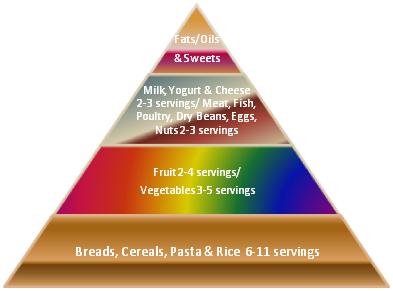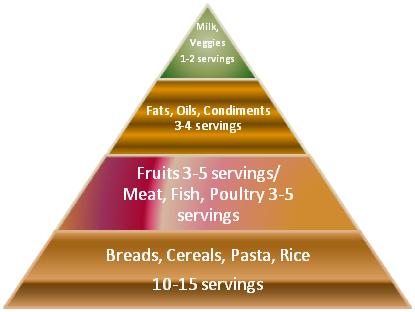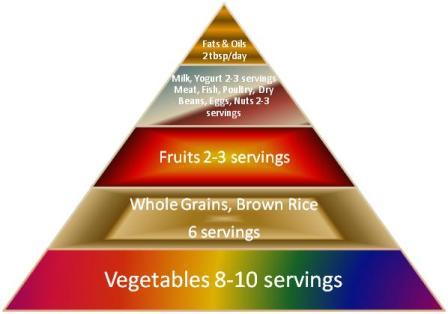What Is A Fit Food Pyramid?
A fit food pyramid differs from the usual industry driven guidelines in the way it is stacked, in the number of servings suggested, and in the specific types of servings. In order to understand, you will need to review the traditional food pyramid.
The traditional pyramid consists of a foundation of grains, followed by fruits and vegetables all lumped into one category, then dairy and protein sources, and finally fats, oils, and all the sticky sweets and candies. This may be the way dieticians want you to eat, stating that it's good for your health, but let’s face it, most people employ a modified version of the pyramid based on their own personal preferences.
The dietician’s food pyramid looks something like this:

The average person's food pyramid looks something like this:

The differences are obvious. People tend to eat a lot more staples/grains, followed by a large amount of protein, more fruits than vegetables, and sometimes an adequate amount of dairy.
Draw a food pyramid of your own – and be honest with your answers.
I’m not a fan of either of the above mentioned pyramids. I would like to propose a new fit food pyramid.
Fit Food Pyramid:

To expand on a Fit Body image, here are some food guidelines to help you achieve your best look.
- Try to eat as many vegetables in as many colours as you can each day. The phytonutrients differ from plant to plant and eating a wide variety in a wide range of colours will help you receive your required nutrients each day. Besides their vitamin and mineral content, they contain enzymes that help your body get rid of toxins. Another reason to eat more vegetables is their alkaline/ash forming residue.
- Include the following whole grains and rice in your daily meals: quinoa, sprouted grain breads, whole wheat pitas, rolled oats (not the instant kind), and brown and wild rice. If you have a problem digesting wheat products, stick with the brown & wild rice and pick up some pure corn, arrowroot, barley, rice, or potato bread from any health food store.
- Fruits are good for you, but only to a certain point. They are filled with phytonutrients – that’s good - but they are also acid forming in your system – that’s bad. Fruits are composed of simple sugars so think fast energy as opposed to sustained energy. Although it’s important to include fruits in your diet, you need to limit the quantity. If you’re currently eating a lot of fruit, switch out some of the fruit servings for servings of vegetables. You’ll still get your phytonutrients, but you won’t contribute as much to an acidic pH.
- Milk and yogurt are better options for dairy products. People usually can’t stop at a one and a half ounce serving of cheese and end up taking in more fat than they had planned on. Dairy products are rich sources of calcium, so make sure you’re getting yours. If you’re lactose intolerant or have an allergy, try fortified soy milk or rice milk. A word of caution with soy products – if you have problems with estrogen levels, soy products are not a good choice.
- Increase your frequency of fish and dried beans as protein sources throughout the week. You receive healthy oils and high quality protein from cold water fish and dried beans whereas you may receive high quality protein from red meats but you also receive saturated fats and none of the preferred oils.
- Include healthy fats and oils with your daily meals. Examples include avocados, nut butters, cold pressed extra virgin olive oil and flax seed oil. The oils can be drizzled over your food after cooking. Tip: please do not use the oils to cook with -you’ll destroy them if you do.
You may not want to adopt all the principles in this fit food pyramid, but at least try to adopt two or three. They will assist you on your road to better health, both inside and out.
Get excited about your body…and eat your vegetables!
Return from Fit Food Pyramid to Weight Management
Return from Fit Food Pyramid to My Health Site Home Page



